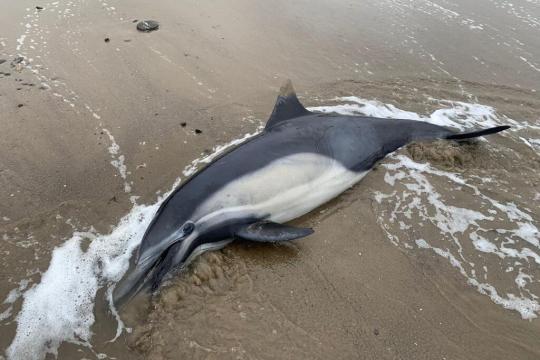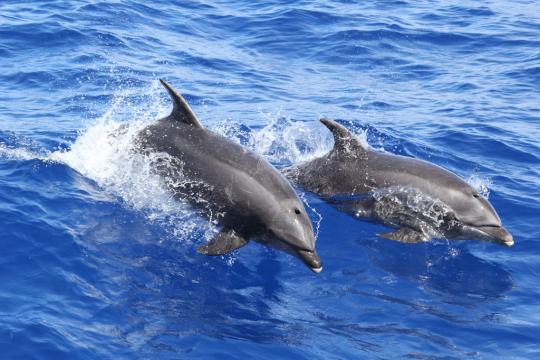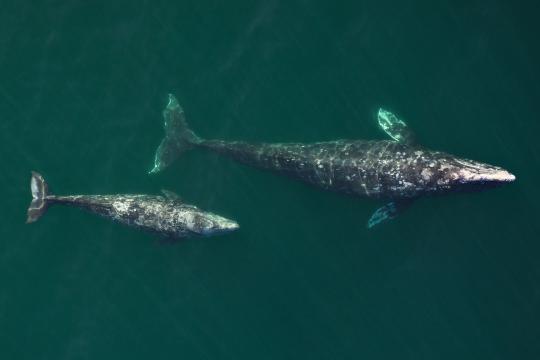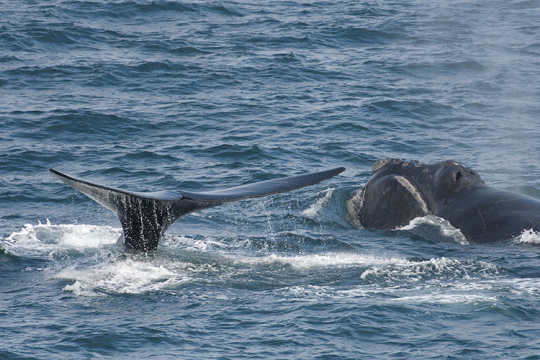Dall’s Porpoise (original) (raw)
 Dall's porpoise. Credit: NOAA Fisheries
Dall's porpoise. Credit: NOAA Fisheries
Dall's porpoise. Credit: NOAA Fisheries
About the Species
Dall's porpoises are common in the North Pacific Ocean and can be found off the U.S. West Coast from California to the Bering Sea in Alaska. These porpoises are considered the fastest swimmers among small cetaceans, reaching speeds of 34 miles per hour over short distances. They are named for W.H. Dall, an American naturalist who collected the first specimen of this species.
A special characteristic of Dall’s porpoises is their distinctive color pattern: a black body with a conspicuous white lateral patch on the left, right, and underside. They are often mistaken for baby killer whales, but unlike killer whales, their dorsal fins are triangle-shaped and they do not have eye patches or saddle patches.
Dall’s porpoises, like all marine mammals, are protected under the Marine Mammal Protection Act.
Population Status
For management purposes, Dall's porpoises inhabiting U.S. waters have been divided into the Alaska stock and the California/Oregon/Washington stock. There are insufficient data available on current population trends for both stocks, but Dall's porpoises are considered reasonably abundant.
Review the most recent stock assessment reports with population estimates
In the western North Pacific Ocean, there are an estimated 104,000 Dall’s porpoises off of Japan, 554,000 in the Okhotsk Sea, 100,000 in the U.S. West Coast stock, and 83,000 in Alaska.
Two distinct subspecies are currently recognized within the species based on distinguishable color patterns: P. d. truei and P. d. dalli. The _truei_-type is abundant only in waters around the Kuril Islands and off the Pacific coast of northern Japan, while the _dalli_-type ranges across the northern North Pacific—from northern Japan to the Bering Sea and into California. Other variable and hybrid types (with harbor porpoises) are also relatively common.
Appearance
Dall's porpoises have a relatively small, triangular head with little or no beak and a thick, robust body. Their flippers are small, round, and located near the front of the body. The triangular dorsal fin is positioned in the middle of the back, and often angles forward. The tail stock and keel (where the caudal fin attaches to the body) are exaggerated and create a pronounced hump, which is large compared to other marine mammals. Adult males have a thicker tail stock and forward-projecting dorsal fin.
Their coloration is very dark gray or black with contrasting white markings on the dorsal fin and tail that distinguish Dall’s porpoises from other cetaceans. All-black (melanistic) and all-white (albino) forms also exist but are considered rare. Markings and colorations vary by geographic location and life stage, with adults having more distinct colorations. Adults also have a chunkier and more robust body than juveniles.
Behavior and Diet
Dall’s porpoises can dive up to 1,640 feet to feed on small schooling fish (e.g., anchovies, herring, and hake), mid- and deep-water fish (e.g., lanternfish and smelts), cephalopods (e.g., squid and octopus), and occasionally crustaceans (e.g., crabs and shrimp). Feeding usually occurs at night when their prey migrates up toward the surface. They have 38 to 56 very small, spade-shaped teeth (about the size of a piece of grain or rice) on each jaw that are useful for grasping.
Dall’s porpoises are usually found in groups averaging between two and 12 individuals, but they have been occasionally seen in larger, loosely associated groups in the hundreds or even thousands of animals. Groups may be fluid as they form and break-up to feed and play. They are known to associate with Pacific white-sided dolphins and short-finned pilot whales but have also been seen swimming alongside large whales. As rapid, social swimmers, Dall’s porpoises are also attracted to fast moving vessels and commonly bowride beside ships. They briskly surface while swimming, creating a "rooster tail" of water spray that is a unique characteristic of the species.
Dall's porpoises emit low-frequency clicks that are presumably used for echolocation.
Where They Live
Dall’s porpoises prefer temperate to boreal (northern, cold) waters that are more than 600 feet deep and with temperatures between 36° Fahrenheit and 63° Fahrenheit. They can be found in offshore, inshore, and nearshore oceanic waters, between 30° North and 62° North. Dall's porpoises occur throughout the coastal and pelagic waters of the North Pacific Ocean. This species is commonly found in the Gulf of Alaska, Bering Sea, Okhotsk Sea, and Sea of Japan. In the eastern North Pacific Ocean, they can be found from around the U.S./Mexico border (Baja California, 32° North) to the Bering Sea, in the central North Pacific Ocean (above 41° North), and in the western North Pacific from central Japan (35° North) to the Okhotsk Sea. In the Bering Sea, Dall’s porpoises occur in higher abundance near the shelf break. They are commonly seen in inshore waters of Washington, British Columbia, and Alaska. Migration patterns (inshore/offshore and north/south) are based on morphology/type, geography, and seasonality.
 World map providing approximate representation of the Dall's porpoise's range.
World map providing approximate representation of the Dall's porpoise's range.
Lifespan & Reproduction
Dall's porpoises become sexually mature at 3.5 to 8 years of age and give birth to a single calf after a gestation period of 10 to 12 months, usually between June and September. The calves are generally 3.3 feet long and are nursed by their mother for less than one year. These cetaceans can live up to 22 years, but their lifespan is generally 15 to 20 years.
Hybrids between Dall's porpoises and harbor porpoises are also fairly common in the northeast Pacific ocean but can also occur elsewhere.
Threats
Entanglement
One of the main threats to Dall’s porpoises is becoming entangled or captured in commercial fishing gear such as drift nets, gillnets, and trawls. This occurs in fisheries targeting groundfish, salmon, and squid in Canadian, Russian, Japanese, Alaskan, and other U.S. waters. Once entangled, porpoises can become anchored or may swim off with the gear attached for long distances, ultimately resulting in fatigue, compromised feeding ability, or severe injury, which may lead to reduced reproductive success and death.
Hunting
Japanese fisherman hunt Dall’s porpoises in the western North Pacific ocean as a source of meat for human consumption, where approximately 18,000 Dall’s porpoises are taken annually. There are no reports of subsistence take of Dall’s porpoise in Alaska.
Contaminants
Contaminants enter ocean waters and sediments from many sources—such as wastewater treatment plants, sewer outfalls, and pesticide application—and move through the food chain. Pollutants and various contaminants in the marine environment have been found in the blubber of Dall's porpoises. These pollutants can harm their immune and reproductive systems.
Modern pollution controls have reduced but not eliminated many chemical contaminants, which continue to threaten Dall's porpoises. Additionally, some of these contaminants persist in the marine environment for decades and continue to threaten marine life.
Ocean Noise
Underwater noise pollution interrupts the normal behavior of Dall’s porpoises and interferes with their communication.
Scientific Classification
| Kingdom | Animalia |
|---|---|
| Phylum | Chordata |
| Class | Mammalia |
| Order | Cetacea |
| Family | Phocoenidae |
| Genus | Phocoenoides |
| Species | dalli |
Last updated by NOAA Fisheries on 09/15/2022
What We Do
Conservation & Management
NOAA Fisheries is committed to protecting Dall’s porpoises. Targeted management actions taken to protect these animals include:
- Addressing ocean noise
- Overseeing marine mammal health and stranding response
- Educating the public about Dall’s porpoises and the threats they face
- Monitoring population abundance and distribution
Learn more about our conservation efforts
Science
Our research projects have discovered new aspects of Dall’s porpoise biology, behavior, and ecology and help us better understand the challenges that all Dall’s porpoises face. This research is especially important in maintaining stable populations. Our work includes:
- Stock assessments
- Aerial surveys
- Measuring the response of animals to sound using digital acoustic recording tags
- Satellite tagging and tracking
How You Can Help
![]()
Report Marine Life in Distress
Report a sick, injured, entangled, stranded, or dead animal to make sure professional responders and scientists know about it and can take appropriate action. Numerous organizations around the country are trained and ready to respond. Never approach or try to save an injured or entangled animal yourself—it can be dangerous to both the animal and you.
Learn who you should contact when you encounter a stranded or injured marine animal
![]()
Keep Your Distance
![]()
Report a Violation
Call the NOAA Fisheries Enforcement Hotline at (800) 853-1964 to report a federal marine resource violation. This hotline is available 24 hours a day, 7 days a week for anyone in the United States.
You may also contact your closest NOAA Office of Law Enforcement field office during regular business hours.
![]()
Do Not Interact With Marine Animals in the Wild
Do not harass, feed, hunt, capture, kill, pursue, approach, surround, swim with, or attempt to touch protected marine wildlife. Never entice protected marine wildlife to approach you.
Do not engage, chase, or try to get a reaction from the animal. Disturbing wildlife interrupts their ability to perform critical functions such as feeding, breeding, nursing, resting, and socializing.
If you’re on a vessel and a marine animal approaches you, put the engine in neutral and allow the animal to continue on its way.
-
Featured News
 Deceased dolphin as a result of domoic acid poisoning. Credit: Channel Islands Marine & Wildlife Institute
Deceased dolphin as a result of domoic acid poisoning. Credit: Channel Islands Marine & Wildlife Institute
 Pair of bottlenose dolphins. Credit: NOAA Pacific Islands Fisheries Science Center/Lisa Morse.
Pair of bottlenose dolphins. Credit: NOAA Pacific Islands Fisheries Science Center/Lisa Morse.
 Gray whales were nearly hunted to extinction by commercial whaling. Protections under the MMPA, ESA, and the end of commercial whaling have allowed the species to recover. Credit: NOAA Fisheries (Permit #19091).
Gray whales were nearly hunted to extinction by commercial whaling. Protections under the MMPA, ESA, and the end of commercial whaling have allowed the species to recover. Credit: NOAA Fisheries (Permit #19091).

Management Overview
Like all marine mammals, the harbor porpoise is protected under the Marine Mammal Protection Act. NOAA Fisheries is working to conserve this species in many ways, with the goal that its population will remain stable.
Dall's porpoise in Alaska. Credit: NOAA Fisheries/Kate Stafford
Conservation Efforts
Addressing Ocean Noise
Sound pollution threatens Dall’s porpoise populations by interrupting their normal behavior and driving them away from areas important to their survival. Increasing evidence suggests that exposure to intense underwater sound in some settings may cause some porpoises to strand and ultimately die.
NOAA Fisheries is investigating all aspects of acoustic communication and hearing in marine animals. In 2018, we updated our marine mammal acoustic technical guidance for assessing the effects of anthropogenic sound on marine mammal hearing.
Overseeing Marine Mammal Health and Stranding Response
We work with volunteer networks in all coastal states to respond to marine mammal strandings including all dolphins and porpoises. When stranded animals are found alive, NOAA Fisheries and our partners assess the animal’s health and determine the best course of action. When stranded animals are found dead, our scientists work to understand and investigate the cause of death. Although the cause often remains unknown, scientists can sometimes attribute strandings to disease, harmful algal blooms, vessel strikes, fishing gear entanglements, pollution exposure, and underwater noise. Some strandings can serve as indicators of ocean health, giving insight into larger environmental issues that may also have implications for human health and welfare.
Learn more about the Marine Mammal Health and Stranding Response Program
Marine Mammal Unusual Mortality Events
Dall’s porpoise have never been part of a declared unusual mortality event. Under the Marine Mammal Protection Act, an unusual mortality event is defined as "a stranding that is unexpected; involves a significant die-off of any marine mammal population; and demands immediate response." To understand the health of marine mammal populations, scientists study unusual mortality events.
Get information on active and past UMEs
Get an overview of marine mammal UME
Educating the Public
NOAA Fisheries aims to increase public awareness and support for Dall’s porpoise conservation through education, outreach, and public participation. We regularly share information with the public about the status of Dall’s porpoises, as well as our research and efforts to maintain their populations.
Regulatory History
This species is protected under the Marine Mammal Protection Act of 1972, as amended.
Key Actions and Documents
Last updated by NOAA Fisheries on 09/15/2022
Science Overview
NOAA Fisheries conducts various research activities on the biology, behavior, and ecology of the Dall’s porpoise. The results of this research are used to inform management decisions for this species.
Stock Assessments
Determining the number of Dall’s porpoises in each population—and whether a stock is increasing or decreasing over time—helps resource managers assess the success of enacted conservation measures. Our scientists collect information and present these data in annual stock assessment reports.
Alaska Fisheries Science Center Dall's Porpoise Research
Find out more about what our scientists are learning about Dall's porpoises in Alaska
Dall's porpoise in Alaska. Credit: NOAA Fisheries/Marilyn Dahlheim
Last updated by NOAA Fisheries on 09/15/2022
Documents
Research
California Current Marine Mammal Assessment Program
The California Current Marine Mammal Assessment Program conducts research on population assessment for species inhabiting waters off the U.S. West Coast, and on improving assessment methodology for application throughout the U.S. and internationally. We…
Dall's Porpoise Research in Alaska
Scientists at NOAA Fisheries’ Auke Bay Laboratories have mapped Dall’s porpoise distributions in Prince William Sound for the first time in nearly three decades. The research was part of Gulf Watch Alaska, a program that monitors the long-term ecosystem…
Outreach & Education
Last updated by NOAA Fisheries on 09/15/2022